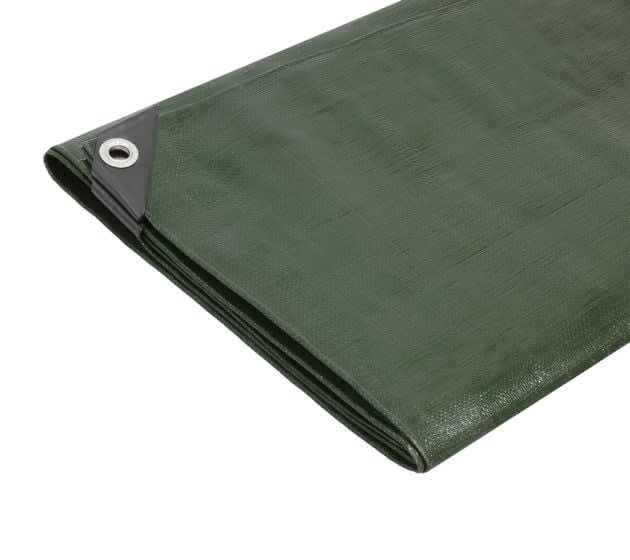Tarpaulins
(11 Products)Durable weather-resistant sheeting designed to provide flexible temporary coverage and protection for materials, structures, and equipment. Available in standard blue and heavy-duty green grades for general and high-demand applications across construction, agriculture, and industrial settings.
Understanding Tarpaulins
Tarpaulins are flexible waterproof or water-resistant sheets manufactured from woven polyethylene, canvas, or PVC-coated fabrics.
They are used extensively in construction, transport, and storage to provide temporary shelter, cover exposed structures, and protect materials from weathering, moisture ingress, and dust contamination. The sheets are reinforced with hems and eyelets, allowing secure fastening and tensioning across scaffolds, frames, or ground surfaces.
In construction and civil engineering contexts, tarpaulins serve both as protective sheeting and containment barriers during site operations. Their mechanical strength, UV resistance, and tear resistance vary by grade and weight, allowing selection according to site exposure, duration, and load conditions.
Standard blue tarpaulins are typically lightweight and economical, offering reliable protection for general site coverage, material wrapping, or short-term weatherproofing. Heavy-duty green tarpaulins provide enhanced resistance to abrasion, UV degradation, and tearing, making them suitable for prolonged outdoor use, roof protection, and containment applications.
High-quality tarpaulins conform to recognised performance criteria for tensile strength, coating adhesion, and waterproofing, ensuring long service life under variable site conditions.
Material Range
- Standard Blue Tarpaulins: Polyethylene woven sheets with LDPE laminated surfaces, lightweight and cost-effective for general temporary coverage.
- Heavy Duty Green Tarpaulins: Heavier-grade PE or PVC-reinforced fabric with strong mesh weave and double-laminated finish for extended durability and weather resistance.
- Reinforced Eyelet Sheeting: Tarpaulins fitted with aluminium or steel eyelets at regular intervals for secure tie-down and attachment.
Key Features
- Waterproofing: Impermeable laminated construction prevents water penetration and material spoilage.
- UV Resistance: Coatings resist ultraviolet degradation during long-term outdoor exposure.
- Tear Strength: Reinforced weave maintains integrity under tension and wind load.
- Flexibility: Lightweight and easily handled, folded, and secured.
- Chemical Resistance: Stable against common construction-site contaminants.
- Reinforced Edges: Heat-sealed hems and metal eyelets improve attachment performance.
- Temperature Tolerance: Suitable for use in varying weather conditions and environments.
Typical Applications
- Site Protection: Covering scaffolds, building frames, and stored materials during construction phases.
- Temporary Roofing: Providing short-term shelter over exposed roof areas during repair or replacement works.
- Ground Sheeting: Acting as a base layer beneath aggregates, temporary flooring, or containment zones.
- Transport Cover: Securing loads on vehicles and trailers against rain and dust.
- Agricultural Use: Protecting hay, equipment, and produce from weather exposure.
Specification & Standards
- BS EN ISO 2286-2: Specifies methods for determining mass per unit area and thickness of coated fabrics.
- BS EN 13206: Covers requirements for plastic films used in construction and protection applications.
- BS 7837: Defines flammability performance requirements for flexible plastics used in tents and tarpaulins.
- DIN 53363 / ISO 4674: Methods for measuring tear resistance of coated fabrics.
Related Materials and Construction Uses
Tarpaulins integrate with scaffolding systems, debris netting, ground membranes, and weatherproof sheeting to provide comprehensive site protection.
They are used alongside fixings, ropes, and bungee cords for secure installation and can complement temporary fencing, hoarding, and enclosure systems. Within civil works, tarpaulins often accompany damp-proof membranes, vapour barriers, and geotextiles as part of surface protection and environmental containment strategies.
Frequently Asked Tarpaulins Questions
What Are Standard Blue Tarpaulins Made From?
Standard blue tarpaulins are typically made from lightweight polyethylene (PE) with a laminated waterproof coating, reinforced hems, and aluminium eyelets for securing. They are designed for general-purpose, short-term covering applications.
What Is The Difference Between Standard Blue And Heavy Duty Green Tarpaulins?
Heavy duty green tarpaulins are thicker, with higher GSM (grams per square metre), stronger corner reinforcement, and UV protection, making them suitable for long-term outdoor or industrial use compared to the lighter blue versions.
Are Tarpaulins Waterproof?
Most polyethylene tarpaulins are fully waterproof due to their laminated surface. Stitching and seams should be properly sealed or heat-welded to maintain complete water resistance.
How Is GSM Related To Tarpaulin Strength?
GSM (grams per square metre) measures fabric weight and density. Higher GSM values indicate stronger, thicker, and more durable tarpaulins suitable for demanding environments such as construction or heavy transport.
Can Tarpaulins Be Used Outdoors Long-Term?
Heavy duty tarpaulins with UV-stabilised coatings and reinforced edges are suitable for extended outdoor exposure. Standard tarpaulins are better suited for temporary or occasional outdoor use.
How Should Tarpaulins Be Secured?
Tarpaulins should be fixed using bungee cords, rope, or elastic ties through reinforced eyelets. Ensure even tension and avoid sharp edges that may damage the fabric.
Are Tarpaulins Fire Retardant?
Some tarpaulins are manufactured to fire retardant standards such as BS 7837. Standard blue and green tarpaulins are not typically fire retardant unless specified.
How Should Tarpaulins Be Cleaned And Stored?
Clean tarpaulins with mild detergent and water, then dry fully before folding. Store in a cool, dry area away from direct sunlight to prevent degradation of coatings and eyelets.


